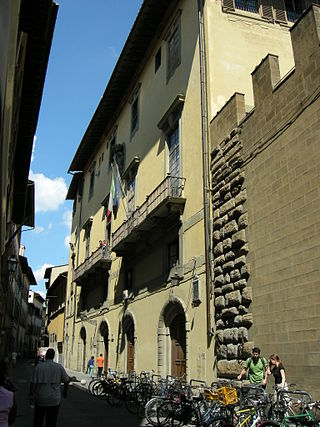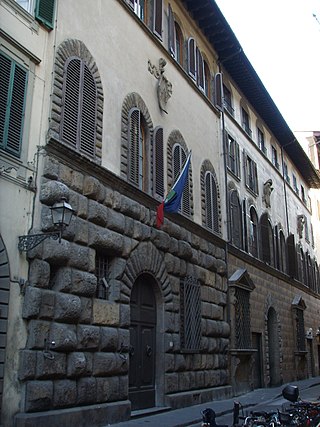
The Palazzo Gerini is a Renaissance-style palace located on via Ricasoli 42 in Florence, Italy.

The Palazzo Gerini is a Renaissance-style palace located on via Ricasoli 42 in Florence, Italy.

Via Ricasoli was previously called Via del Cocomero. At the site of this palace in the 15th-century were two houses owned by the Ginori family, who sold it to Piero da Gagliano, who then sold it to the Salviati family in 1579. The Salviati engaged the architect Bernardo Buontalenti to help restructure the site.
However, in 1650, the Gerini family, under the newly minted Marchese Carlo Gerini, secretary of the cardinal Carlo de' Medici purchased the palace and refurbished the interiors, commissioning frescoes from Anton Domenico Gabbiani and Jacopo Chiavistelli. In 1752, the main entrance and stairwell was refurbished under the designs of Gaspare Maria Paoletti. In 1798, the family had bought the adjacent palace at #40, and at the turn of the 19th century, Giuseppe Poggi, remodeled it to resemble the other facade. This refurbishment damaged many of the frescoes on the piano nobile. Until 1825, the palace held a highly prestigious collections of paintings, including works by or attributed to Piero di Cosimo, Domenico Ghirlandaio, Andrea del Sarto, Carlo Dolci, and Rembrandt. [1]

The Palazzo Vecchio is the town hall of Florence, Italy. It overlooks the Piazza della Signoria, which holds a copy of Michelangelo's David statue, and the gallery of statues in the adjacent Loggia dei Lanzi.

Villa del Poggio Imperiale is a predominantly neoclassical former grand ducal villa in Arcetri, just to the south of Florence in Tuscany, Central Italy. Beginning as a villa of the Baroncelli of Florence, it was seized by the Medici, became the home of a homicidal and unfaithful husband, and a lavish retreat for a Grand Duchess with imperial pretensions. Later given to Napoleon's sister, it was reclaimed by the hereditary rulers of Tuscany before being finally converted to a prestigious girls' school. During its long history, it has often been at the centre of Italy's turbulent history, and has been rebuilt and redesigned many times.

Palazzo Mozzi or Palazzo de' Mozzi is an early Renaissance palace, located at the end of the Piazza de' Mozzi that emerges from Ponte alle Grazie and leads straight to the palace where via San Niccolò becomes via de' Bardi in the Quartiere of Santo Spirito in the Oltrarno section of Florence, region of Tuscany, Italy. The 13th-century palace housed the gallery of the highly successful antiquarian Stefano Bardini, of which the remnants were left to the commune, where they assembled the Museo Bardini or Mozzi Bardini, displaying Florentine art and artifacts up to the early Renaissance. The gardens elaborated against the hillside behind the palace were added mainly by Bardini.
The decade of the 1460s in art involved some significant events.

Giovanni Tornabuoni was an Italian merchant, banker and patron of the arts from Florence.

Antonio Francesco Gori, on his titlepages Franciscus Gorius, was an Italian antiquarian, a priest in minor orders, provost of the Baptistery of San Giovanni from 1746, and a professor at the Liceo, whose numerous publications of ancient Roman sculpture and antiquities formed part of the repertory on which 18th-century scholarship as well as the artistic movement of neoclassicism were based. In 1735 he was a founding member of a circle of antiquaries and connoisseurs in Florence called the Società Colombaria, the predecessor of the Accademia Toscana di Scienze e Lettere la Colombaria, to foster "not only Tuscan Poetry and Eloquence, or one faculty only; but almost all the most distinguished and useful parts of human knowledge: in a word, it is what the Greeks called Encyclopedia".


The Villa Salviatino, Maiano, in the frazione of Maiano on the steep slope south of Fiesole, is a Tuscan villa overlooking Florence.

The Biblioteca Riccardiana is an Italian public library under the aegis of the Ministry of Culture, located inside the Palazzo Medici Riccardi at 10 Via de’ Ginori in Florence, in the neighborhood comprising the Mercato Centrale and the Basilica di San Lorenzo. Its main feature is preserving books collected by members of the Riccardi family and making them available in the very same rooms that were originally dedicated to that purpose. So, still today the library boasts the magnificent bookshelves, neatly carved and gilded, that create the atmosphere of a late-seventeenth-century patrician library, whose main features have all been kept intact.

The Palazzo Capponi Covoni is a Baroque architecture palace in Florence, region of Tuscany, Italy. There are apparently three other palaces once associated with the Capponi family:

The Casino Mediceo di San Marco is a late-Renaissance or Mannerist style palace located on Via Cavour number 57 and via San Gallo in Florence, region of Tuscany, Italy.

The Palazzo del Circolo dell'Unione, also once known across the centuries as the Palazzo Corsi, Montauto, or della Commenda da Castiglione, is a late-Renaissance-style palace located on Via Tornabuoni #7 in central Florence, region of Tuscany, Italy. In 2015, it still houses the Circolo society, and houses among other enterprises, a boutique hotel.

The Palazzo Nasi, also known as the Palazzo Torrigiani or Palazzo Scarlatti, is a palace located at Piazza de' Mozzi 4, down the street where the Ponte alle Grazie enters the Oltrarno, in Florence, Tuscany, Italy. Another Palazzo Torrigiani Del Nero, with a Mannerist or late-Renaissance-style facade stands closer to the river. Both palaces also once belonged to the Nasi. The palace is a few steps from the Palazzo Mozzi.

Palazzo Ginori is a Renaissance-style palace in Via de' Ginori # 11 in the Quartieri San Giovanni of the city of Florence, Italy.

The Palazzo or Casa Martelli was a residential palace, and since 2009, a civic museum displaying in situ the remains of the original family's valuable art collection, as well as its frescoed rooms. The palace is located on Via Ferdinando Zannetti 8 near the corner with Via Cerretani in central Florence, region of Tuscany, Italy.
The Palazzo Tempi, also known as Palazzo Vettori or Bargagli Petrucci, is a palace located along the Arno river at the narrow Piazza Santa Maria Soprarno 1, corner with Via de' Bardi and Costa dei Magnoli in the Oltrarno section of Florence, Tuscany, Italy. The palace is across the river from the Galleria of the Uffizi, and a block east of the Ponte Vecchio. The Via de' Bardi originates in an arch under the building.

The Church of Santa Maria Primerana is a Roman Catholic church located in the Tuscan town of Fiesole. It encloses the eastern end of Piazza Mino, next to the Praetorian Palace.

Giovanni Corsi was a noble Italian Marquis, Knight, Patron, Ambassador and Senator of Florence in 1637. He was the second Marquis of Caiazzo, title he inherited after Bardo Corsi death in 1624.

The Casa Vasari is a building at 8 borgo Santa Croce in Florence, previously the residence in that city of the painter, art historian and architect Giorgio Vasari. It preserves a valuable cycle of frescoes in the hall, conceived and created by Vasari with the help of pupils.

Palazzo Neroni is a historic building in the centre of Florence, located at via de' Ginori 7, with a rear entrance also at via della Stufa 4r-6r.